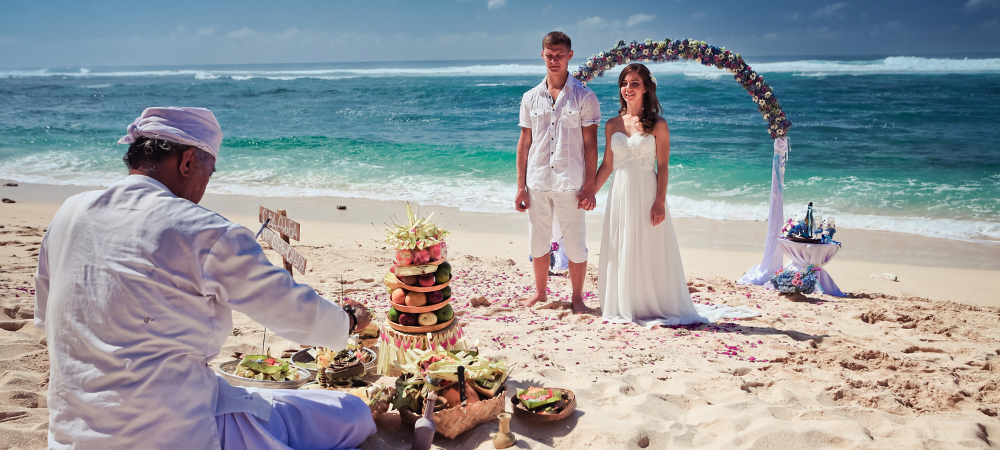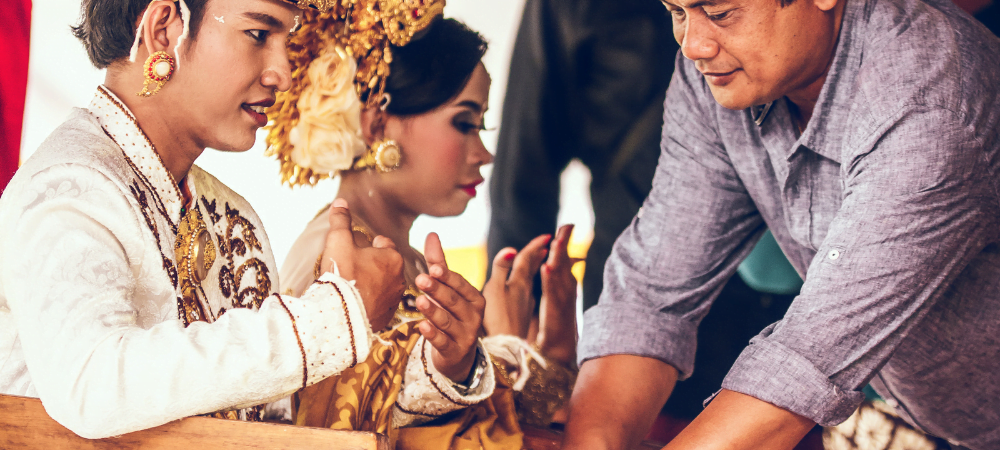Traditional Balinese Weddings
A Balinese wedding is more than a union of two people — it’s a deeply spiritual and cultural experience. From elaborate ceremonies and symbolic attire to family blessings and vibrant community celebrations, each step of a traditional Balinese wedding reflects the island’s rich Hindu heritage and communal values.
Whether you’re attending a Bali traditional wedding, curious about Balinese wedding customs, or planning your own ceremony in Bali, this guide will walk you through everything from the rituals and meaning behind Balinese wedding attire to the post-wedding traditions that make these ceremonies truly unforgettable. And if you are planning to spend your honeymoon on the island too, here is our guide on it.
Key Takeaways
- Balinese weddings are deeply spiritual and involve multiple rituals before, during, and after the ceremony, highlighting the union of families and respect for ancestors.
- Traditional wedding attire features rich symbolism — brides wear ornate kebayas and crowns, while grooms don udeng headdresses and ceremonial sarongs.
- Pre-wedding customs like Ngekeb (purification) and Mapadik (formal engagement) lay the groundwork for the marriage with blessings and family unity.
- Post-wedding rituals such as Nyekah and Ngerorasin strengthen ancestral ties and mark the couple’s integration into community life.
- Guests should dress modestly, bring small gifts or monetary offerings if invited, and follow etiquette, especially in religious or ceremonial spaces.
- Some traditional weddings are open to tourists through cultural villages or temple ceremonies, offering a respectful way to experience Balinese traditions.
Pre-Wedding Rituals in a Traditional Balinese Wedding
Traditional Balinese weddings begin with a series of pre-wedding rituals that are as important as the wedding ceremony itself. These rituals not only prepare the couple spiritually and physically but also set the foundation for their life together. Here is a deeper look into these enchanting pre-wedding customs:
Ngekeb: Purification Ritual
The ‘Ngekeb’ is a purification ritual performed separately for the bride and groom in their respective family homes. This ceremony is crucial as it cleanses them of negative energies and prepares them for a harmonious married life. The participants include close family members who provide emotional support and blessings.
Mapadik: Formal Engagement
Following the purification, the formal engagement ceremony, or ‘Mapadik’, takes place. During this event, the groom visits the bride’s home with his family to formally ask for her hand in marriage. This ritual solidifies the union between the two families and involves the exchange of gifts that typically include traditional fabrics, foods, and sometimes even livestock, symbolizing wealth and prosperity.
Mepamit: Asking for Permission
In the ‘Mepamit’ ritual, the couple visits relatives to ask for their blessings. This is not only a sign of respect but also an invitation to the wedding. It’s an opportunity for the couple to receive wisdom and advice from elder family members, which is considered essential for a successful marriage.
Memadik: Agreement between Families
‘Memadik’ is the ceremony where both families meet to discuss and agree upon the marriage arrangements. This includes the wedding date, financial arrangements, and expectations from each side. This ritual emphasizes the importance of unity and understanding between the families, which is vital for the couple’s future.
Ngidih: Dowry Negotiation
Unlike in many cultures, in Balinese tradition, the dowry (or ‘Ngidih’) is typically given by the groom’s family to the bride’s. This dowry can consist of money, gold, or other valuables. The negotiation of the dowry is handled delicately, as it reflects the respect and value placed on the bride and her family’s contribution to the new union.
Each of these rituals is accompanied by specific prayers, offerings, and traditional music and dance, making the lead-up to a Balinese wedding a deeply spiritual and communal affair.
The Wedding Day
The wedding day in a traditional Balinese ceremony is a vibrant and spiritually charged event. It’s a day filled with elaborate rituals that not only unite the couple but also reinforce the community’s cultural traditions. Here’s what a typical wedding day looks like in Bali:
Morning Preparations
The day begins early with both the bride and groom preparing at their respective homes. The families and community members come together to help, creating an atmosphere of communal support. The bride and groom are dressed in elaborate traditional attire, which includes intricate headpieces, gold jewelry, and ornate fabrics that signify their new status.
Procession to the Bride’s Home
Accompanied by a procession of family and friends, the groom travels to the bride’s home. This procession is typically festive, featuring traditional music, dance, and sometimes even a gamelan orchestra. The arrival of the groom is a significant event, marked by ceremonial greetings and offerings to the bride’s ancestors.
The Handover Ceremony (Meduwe Keris)
At the bride’s home, a ritual called ‘Meduwe Keris’ takes place where the bride is formally handed over to the groom. It’s a poignant moment that symbolizes the bride leaving her family to start a new life. The ceremony is conducted by a priest and involves prayers and offerings to ensure the couple’s future prosperity and happiness.
Exchange of Vows and Rings (Peningetan)
Following the handover, the couple exchanges vows and rings. This part of the ceremony is somewhat similar to Western traditions but is deeply infused with Balinese spiritual elements. The vows are blessings recited by the priest, asking for divine approval and happiness for the couple.
Water Purification Ritual (Mejaya-jaya)
One of the most important rituals is the ‘Mejaya-jaya’, a water purification ceremony where water from a holy spring is used to bless the couple. This ritual purifies them spiritually and symbolises the washing away of past impurities, preparing them for married life.
Feasting and Festivities
After the formal ceremonies, a grand feast is held. Traditional Balinese dishes are served, and everyone—from the smallest child to the oldest grandparent—joins in the celebration. The atmosphere is jubilant, with music, dancing, and performances that reflect the joy of the occasion.
Community Blessings
As the day progresses, members of the community come forward to offer their blessings. This could involve small rituals, songs, or dances, each adding to the communal spirit of the event.
Closing Rituals
The wedding day concludes with closing rituals that thank the ancestors and gods for their blessings. The couple and their families participate in these rituals, marking the end of the day’s formal ceremonies and the beginning of the couple’s life together.
Traditional Balinese Wedding Attire and Its Symbolism
Traditional Balinese wedding attire is a dazzling showcase of the island’s cultural heritage, incorporating intricate designs, luxurious fabrics, and symbolic colors that enhance the sacredness of the matrimonial ceremony. Each piece of clothing and accessory worn by the bride and groom is rich in cultural significance and meticulously crafted to honor Balinese traditions.
Bride’s Attire:
- Kebaya: The bride typically wears a ‘kebaya’, which is a finely embroidered blouse made from lace or silk. This is often in white or gold, colors that signify purity and sanctity.
- Sarong: Accompanying the kebaya, the bride wears a ‘sarong’, a traditional skirt that may be layered with several pieces, each richly adorned with gold or colorful patterns.
- Selendang: A sash or shawl known as ‘selendang’ is draped over the shoulder or around the waist, adding elegance and completing the ensemble.
- Headpiece: The bride’s headgear is particularly elaborate, typically consisting of a golden crown (gelung) decorated with flowers and sometimes precious stones, symbolizing the beauty and dignity of the bride.
Groom’s Attire:
- Udeng: The groom wears an ‘udeng’, a traditional Balinese headdress that signifies his manhood and wisdom. It is usually patterned and folded artistically.
- Safari Shirt: Beneath the ‘udeng’, the groom wears a ‘safari’ style shirt, often white and made of silk, symbolizing purity.
- Kamben: This is a type of sarong worn by the groom, wrapped around the waist, and usually more subdued compared to the bride’s but still elegant and finely crafted.
- Sash: A sash or belt is worn over the kamben, which helps hold the attire together and often matches the fabric of the udeng.
Jewellery and Accessories:
- Both the bride and groom wear various gold jewelry pieces, such as necklaces, bracelets, and earrings. Gold is preferred for its significance in Balinese culture as a symbol of wealth, prosperity, and divine blessing.
- Accessories might also include a ‘keris’, a traditional dagger, which the groom carries as a symbol of protection and bravery.
Footwear:
- Footwear is usually simple or even absent as many ceremonies take place on sacred ground where it is customary to go barefoot, emphasizing the sanctity and groundedness of the marriage.
The traditional attire worn during a Balinese wedding serves as an expression of cultural identity and spiritual significance. Each element of the attire is prepared with great care to ensure that the couple not only looks magnificent but also feels deeply connected to their ancestral traditions on their special day.

Post-Wedding Rituals
In Balinese culture, the wedding celebration does not conclude with the ceremony and festivities of the wedding day itself. Several significant rituals follow the main event, extending the celebration and emphasizing the integration of the bride into her new family and community. These post-wedding rituals are rich in symbolism and are crucial for the newlyweds as they start their life together.
Medondonan: The Day After the Wedding
The day after the wedding, a ritual called ‘Medondonan’ or ‘Ngunduh Mantu’ is held. This is when the groom brings the bride to his family’s home for the first time as a married couple. The groom’s family welcomes the bride with elaborate ceremonies that include music, dance, and sometimes a ceremonial wash of the couple’s feet, symbolizing their entry into the household.
Mungkah Lawang: Opening the Door
During the bride’s first arrival at her new home, a ritual known as ‘Mungkah Lawang’ (opening the door) is performed. The couple is often required to perform tasks, such as cutting a thread or unlocking a gate, symbolizing the overcoming of obstacles together. This act demonstrates the bride’s readiness to take on her new duties and her acceptance into the groom’s family.
Ngerorasin: Symbolic Feeding
An important post-wedding ritual is ‘Ngerorasin’, where the couple feeds each other small portions of food like rice, fruit, and meat. This act symbolizes mutual care and the commitment to provide for one another. It also serves as a public declaration of their union and their roles as husband and wife.
Nyekah: Honoring the Ancestors
A few days after the wedding, the couple performs ‘Nyekah’, a ceremony that involves making offerings to the ancestors. This ritual is meant to inform the ancestors of the marriage and to ask for their blessings. It is a poignant reminder of the couple’s duties to maintain familial and spiritual connections.
Do You Give Money at a Balinese Wedding?
Yes, it is customary to give a monetary gift when attending a Balinese wedding, especially if you are a guest of the family. There’s no strict amount, but most locals give what they can afford as a token of support and goodwill for the couple’s future. If you’re a foreign guest or tourist invited to a traditional ceremony, a modest cash gift in an envelope is a respectful gesture. Gifts are usually handed discreetly during the event or placed in a designated collection area.
Balinese Wedding Customs and Etiquette for Visitors
If you’re invited to a traditional Balinese wedding, attending is a wonderful way to experience local culture — but it’s important to follow a few customs to show respect:
- What to Wear:
Modest attire is a must. Men should wear a collared shirt (or a traditional batik or safari shirt), long pants or a sarong, and preferably an udeng headscarf if available. Women should wear a conservative blouse or kebaya, with a sarong and a sash around the waist. Covered shoulders and knees are expected for both genders. - Footwear:
Sandals are acceptable, and many guests remove their shoes when entering sacred or ceremonial spaces. - How to Behave:
Remain respectful during rituals — avoid loud conversations, and don’t interrupt or walk in front of ceremonial activities. If you’re taking photos, always ask permission and avoid using flash. - Gift Etiquette:
A small monetary gift in an envelope is a thoughtful gesture. There’s no set amount, but any contribution is appreciated and shows your gratitude for being welcomed into a significant cultural moment. - Other Tips:
Don’t step on canang sari (offerings on the ground), and avoid pointing your feet toward altars or priests. Sit low if the priest is seated to show proper respect.
By observing these customs, you not only show appreciation but help preserve the sacredness of one of Bali’s most important traditions.
Closing Thoughts
Traditional Balinese weddings beautifully showcase Bali’s deep cultural traditions. From the detailed rituals before the wedding to the lively ceremonies on the wedding day and the important customs that follow, each part of the wedding emphasises the importance of community, family, and spiritual beliefs.
Whether you are part of the wedding or just watching, a Balinese wedding gives you a special look into the values that are important to Balinese people, making every wedding not just a personal event, but a celebration of culture.
FAQ
How long does a traditional Balinese wedding last?
A traditional Balinese wedding can span several days, including pre-wedding rituals, the main ceremony, and post-wedding customs. Some families celebrate for up to a week, especially in village settings where community involvement is high.
What do guests wear to a Balinese wedding?
Guests typically wear traditional Balinese attire such as a sarong, sash, and modest blouse or shirt. If you don’t have traditional clothing, modest dress with covered shoulders and knees is acceptable. Many weddings also provide sarongs at the entrance for guests to borrow.
Can tourists attend Balinese weddings?
Yes, tourists are sometimes invited to Balinese weddings, especially if staying with local hosts or through cultural experiences. If invited, it’s important to dress respectfully, follow local customs, and treat the ceremony with reverence.
Do Balinese weddings include religious rituals?
Yes, Balinese weddings are rich in Hindu rituals. These may include offerings to ancestors, purification ceremonies, blessings by priests, and symbolic gestures like sharing food or water to represent unity and harmony.
What happens during the Mejaya-jaya ceremony?
Mejaya-jaya is a spiritual purification ritual in which the couple is blessed with holy water, symbolising a clean start to married life. It’s one of the most sacred moments in the Balinese wedding ceremony.
Is photography allowed at Balinese weddings?
Photography is generally allowed, but it’s best to ask before taking photos—especially during religious rituals. Avoid flash and be respectful of the ceremony space and participants.
- Welcome Back To My Villas in Bali - November 17, 2021





